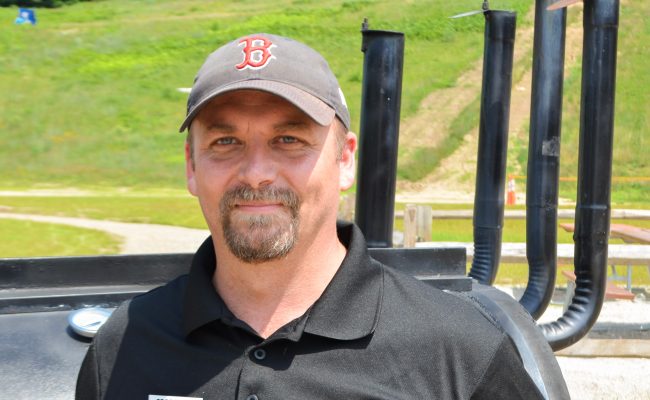There’s just something about an outdoor barbecue that captures the essence of summer: that familiar smoky spice in the air already has your mouth watering, kids laughing as they race around the grass and seeing all your favorite people gather together to enjoy a meal as classically all-American as baseball.
And if there’s one thing Cranmore’s food and beverage director Mike Rennie knows, it’s good barbecue. Check out his top tips and how he plans to share his passion for it through events like Smoke on the Mountain down below!
What are your 3 main tips for smoking meat?
Low and slow is the way to go. In most cases, the temperature of your smoker should be between 225–250 degrees Fahrenheit. Controlling the heat and type of smoke is critical to good barbecue. Thick white billowing smoke is the enemy because it creates bitterness. Thin, clear to blue smoke will produce the best results.
Practice makes perfect. Use less expensive cuts of meat, like chicken thighs or country-style boneless ribs, when getting started. Get to know your smoker and how to control the temp and smoke efficiency (specifically, what produces white smoke versus clear or blue smoke) before getting into larger, more expensive cuts. I’d also recommend using fruit woods like apple or cherry for pork and poultry, and harder woods like hickory and oak for beef.
Make sure to have a good meat thermometer (digital instant-read is best). Poultry should reach an internal temperature of 165 degrees for proper doneness and safety. Larger cuts like a pork shoulder should be finished at 195–200 degrees and a brisket at 205 degrees for the most tender, juicy results that just fall apart. A pork shoulder will take between 9–11 hours and brisket up to 18 hours, depending on the size.
What are you most looking forward to with the return of Smoke on the Mountain (Aug. 16)?
Like with our most recent event, Aloha at the Summit, I’m looking forward to seeing our guests come together with friends and family to enjoy a unique dining experience full of breathtaking views and great food.
How did you learn?
I learned a lot about the science of barbecue during my time at the Culinary Institute of America. However, the real training came in the backyard with friends and family, which involved a lot of trial and error, laughs, and, of course, adult beverages.
What advice would you give to beginners?
Pellet smokers can be a great introduction to the art of barbecue. They are designed for beginners and experienced pit masters alike. Pellet smokers control temperature and smoke production automatically like a crock pot. You can just set it and forget it, as long as you remember to monitor the time and temperature of the meat.
What is your favorite meal you've ever made?
Reverse-seared ribeye steak is my favorite meal. Reverse searing begins low and slow on the smoker until a desired temperature or doneness is achieved, then it is seared on a smoking hot grill.
What would you say is the most important part of barbecue?
The most important thing about barbecue is enjoying the fun and the company that it brings.
You should also keep in mind that barbecue is all a matter of personal preference. Experiment with different cuts of meat, seasoning, rubs, marinades and brines to find your favorite style.
The 3rd annual Smoke on the Mountain on Saturday, Aug. 16, 2025, at 4:30pm. Limited supply of tickets available: $65 for adults and $39 for children (10 and under). Check out the menu and get your tickets before they sell out!
